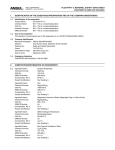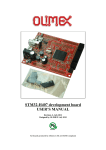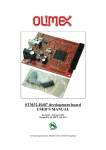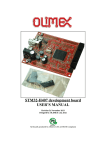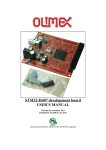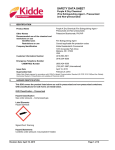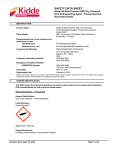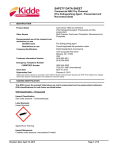Download First Alert 1-A:10-B:C MSDS
Transcript
ANSUL® ANSUL INCORPORATED MARINETTE, WI 54143-2542 FORAY® MATERIAL SAFETY DATA SHEET CONFORMS TO DIRECTIVE 2001/58/EC 1. IDENTIFICATION OF THE SUBSTANCE/PREPARATION AND OF THE COMPANY/UNDERTAKING 1.1. Identification of the preparation Product Name: "FORAY®" Chemical Name: N/A – This is a mixture/preparation. CAS No.: N/A – This is a mixture/preparation. Chemical Formula: N/A – This is a mixture/preparation. EINECS Number: N/A – This is a mixture/preparation. 1.2. Use of the preparation The intended or recommended use of this preparation is as a FIRE EXTINGUISHING AGENT. 1.3. Company identification Manufacturer/Supplier: ANSUL INCORPORATED Address: One Stanton Street, Marinette, WI 54143-2542 Prepared by: Safety and Health Department Phone: 715-735-7411 Internet/Home Page: http://www.ansul.com Date of Issue: September, 2009 1.4. Emergency telephone CHEMTREC 800-424-9300 or 703-527-3887 2. COMPOSITION/INFORMATION ON INGREDIENTS 2.1. Ingredient Name: Chemical Formula: CAS No.: EINECS Number: Concentration, Wt %: Hazard Identification: Monoammonium Phosphate. NH4H2PO4. 7722-76-1. 231-764-5. 65-82 %. See Heading 3. Ingredient Name: Chemical Formula: CAS No.: EINECS Number: Concentration, Wt %: Hazard Identification: Ammonium sulfate (NH4)2SO4. 7783-20-2. 231-984-1. 12-25 %. See Heading 3. Ingredient Name: Chemical Formula: CAS No.: EINECS Number: Concentration, Wt %: Hazard Identification: Magnesium Aluminum Silicate (Attapulgite Clay or Fuller’s Earth). MgxAly(SiO4)z. 8031-18-3. (b). 5-7 %. See Heading 3. Ingredient Name: Chemical Formula: CAS No.: EINECS Number: Concentration, Wt %: Hazard Identification: Calcium Carbonate. CaCO3. 471-34-1. 207-439-9. <2 %. See Heading 3. Ingredient Name: Chemical Formula: CAS No.: EINECS Number: Concentration, Wt %: Hazard Identification: Methyl Hydrogen Polysiloxane. Mixture/preparation. 63148-57-2. (a). <1 %. See Heading 3. FORAY (Continued) Page 2 Ingredient Name: Chemical Formula: CAS No.: EINECS Number: Concentration, Wt %: Hazard Identification: Yellow Pigment C34H30Cl2N6O4. 5468-75-7. 226-789-3 <0.05 %. See Heading 3. (a) EINECS does not include synthetic polymers (these are registered in EINECS under their building blocks, monomers). See: 67/548/EEC, article 13; 79/831/EC; and 81/437/EC. (b) EINECS does not include most naturally occurring raw materials. See: 67/548/EEC, article 13; 79/831/EC; and 81/437/EC. NOTE: Unless a component presents a severe hazard, it does not need to be considered in the MSDS if the concentration is less than 1%. [According to Directive 1999/45/EC]. 3. HAZARDS IDENTIFICATION FOR HUMANS: Product: EU Classification: R Phrases: Xn 22 36/37/38 26 S Phrases: 36 Components: Monoammonium Phosphate: EU Classification: Xn R Phrases: 22 36/37/38 S Phrases: 26 36 Ammonium sulfate: EU Classification: R Phrases: S Phrases: Xi 36/37/38 26 Harmful. Harmful if swallowed. Irritating to eyes, respiratory system, and skin. In case of contact with eyes, rinse immediately with plenty of water and seek medical advice. Wear suitable protective clothing. Harmful. Harmful if swallowed. Irritating to eyes, respiratory system, and skin. In case of contact with eyes, rinse immediately with plenty of water and seek medical advice. Wear suitable protective clothing. Irritant. Irritating to eyes, respiratory system, and skin. In case of contact with eyes, rinse immediately with plenty of water and seek medical advice. Wear suitable protective clothing. 36 Limit Values for Exposure: Nuisance dust limit: OSHA TWA: 15 mg/m3 ACGIH TLV-TWA: 10 mg/m3. Neither this preparation nor the substances contained in it have been listed as carcinogenic by National Toxicology Program, IARC, or OSHA. AS PART OF GOOD INDUSTRIAL AND PERSONAL HYGIENE AND SAFETY PROCEDURE, avoid all unnecessary exposure to the chemical components and ensure prompt removal from skin, eyes, and clothing. SIGNS AND SYMPTOMS: Acute Exposure: Eye Contact:: Mildly irritating for short periods of time. Skin Contact: May be mildly irritating. Inhalation: Treat as a mineral dust. Irritant to the respiratory tract. Transient cough, shortness of breath. Ingestion: Not an expected route of entry. Chronic Overexposure: Inhalation: Chronic fibrosis of the lung, pneumoconiosis. MEDICAL CONDITIONS GENERALLY AGGRAVATED BY EXPOSURE: None known. FOR ENVIRONMENT: No data available. 4. FIRST AID MEASURES Eye Contact: Skin Contact: Inhalation: Ingestion: Flush with water for a minimum of 15 minutes while holding lids open. If irritation persists seek medical attention. Wash affected area with soap and water. If irritation persists seek medical attention. Remove from exposure. If irritation persists seek medical attention. If patient is conscious, give large amounts of water and induce vomiting. Seek medical help. FORAY (Continued) 5. Page 3 FIRE-FIGHTING MEASURES This preparation is an extinguishing media. There are NO extinguishing media which must not be used for safety reasons. NO special protective equipment is needed for fire-fighters. Wear protective equipment appropriate for the fire conditions. 6. ACCIDENTAL RELEASE MEASURES For personal protection: Prevent skin and eye contact, see Heading 8. Clean up: Sweep up and recover for use or place in closed container for disposal, see Heading 13. NO harm to the environment is expected from an accidental release of this preparation. 7. HANDLING AND STORAGE 7.1. Handling Care should be taken in handling all chemical substances and preparations. See incompatibility information in Heading 10. 7.2. Storage NO special conditions are needed for safe storage. See incompatibility information in Heading 10. Store in original container or Ansul fire extinguisher. Keep tightly closed until used. There is minimal danger to the environment from a storage release. 7.3. Specific use The intended or recommended use of this preparation is as a FIRE EXTINGUISHING AGENT. 8. EXPOSURE CONTROLS/PERSONAL PROTECTION 8.1. Exposure limit values Nuisance dust limit: OSHA TWA: 15 mg/m3 ACGIH TLV-TWA: 10 mg/m3. 8.2. Exposure controls 8.2.1. Occupational exposure controls 8.2.1.1. Respiratory protection Dust mask where dustiness is prevalent, or TLV is exceeded. Use mechanical filter respirator if exposure is prolonged. 8.2.1.2. Hand protection None normally needed. Use chemical resistant gloves when handling the preparation. 8.2.1.3. Eye protection Use safety glasses with side shields or safety goggles. 8.2.1.4. Skin protection No special equipment is needed. 8.2.2. Environmental exposure controls No special controls are needed. 9. PHYSICAL AND CHEMICAL PROPERTIES 9.1. General information Appearance: Odor: 9.2. Yellow powder. No odor. Important health, safety, and environmental information pH: Not determined. Boiling point/boiling range: Not applicable. Flash point: None. Flammability (solid/gas): Not flammable. Explosive properties: Not explosive. Oxidizing properties: Not an oxidizer. FORAY (Continued) 9.3. 10. Page 4 Vapor Pressure: Relative Density: Solubility: – Water solubility: – Fat solubility: Partition coefficient, n-octanol/water: Viscosity: Vapor density (Air = 1): Evaporation rate: Not applicable. Not applicable. Slight. Not soluble. Not determined. Not applicable. Not applicable. Not applicable. Other information Auto-ignition temperature: Does not ignite. STABILITY AND REACTIVITY 10.1. Conditions to avoid There are NO known conditions such as temperature, pressure, light, shock, etc., which may cause a dangerous reaction. 10.2. Materials to avoid Strong alkalis, magnesium, oxidizers that can release chlorine or produce Nce3 (explosive) per NFPA 10 Annex A-2-1. 10.3. Hazardous decomposition products Normally stable. Hazardous polymerization will NOT occur. Ammonia and/or phosphorous oxides can be evolved at very high temperatures. 11. TOXICOLOGICAL INFORMATION This product has not been tested for toxicological effects. Product is treated as a nuisance dust. Components: Monoammonium Phosphate: Material is irritating. Harmful if swallowed. Ammonium sulfate: 2840 mg/kg. Toxicity Data: Oral (rat) LD50 Target Organs: Lungs and gastrointestinal. 12. ECOLOGICAL INFORMATION 12.1. Ecotoxicity Not determined. 12.2. Mobility Not determined. 12.3. Persistence and degradability Not determined. 12.4. Bioaccumulative potential Not determined. 12.5. Other adverse effects Ozone depletion potential: Photochemical ozone creation potential: Global warming potential: 13. None. None None DISPOSAL CONSIDERATIONS NO harm to the environment is expected from this preparation. Dispose of in compliance with national, regional, and local provisions that may be in force. FORAY (Continued) 14. Page 5 TRANSPORT INFORMATION Hazard Class or Division: Not a hazardous substance.. For additional transport information, contact Ansul Incorporated. No harm to the environment is expected from this preparation. 15. REGULATORY INFORMATION Product: EU Classification: R Phrases: Xn 22 36/37/38 26 S Phrases: 36 Harmful. Harmful if swallowed. Irritating to eyes, respiratory system, and skin. In case of contact with eyes, rinse immediately with plenty of water and seek medical advice. Wear suitable protective clothing. Limit Values for Exposure: Nuisance dust limit: OSHA TWA: ACGIH TLV-TWA: EINECS Status: 15 mg/m3 10 mg/m3. All components are included in EINECS inventories or are exempt from listing. EPA TSCA Status: All components are included in TSCA inventories or are exempt from listing. Canadian DSL (Domestic Substances List): All components are included in the DSL or are exempt from listing. Environmental restrictions: None are known. Restrictions on Marketing and Use: None are known. Refer to any other national measures that may be relevant. 16. OTHER INFORMATION (HMIS) HAZARDOUS HEALTH: FLAMMABILITY: REACTIVITY: MATERIAL IDENTIFICATION SYSTEM RATINGS: 1 4. Severe Hazard ___ 0 3. Serious Hazard ___ 0 2. Moderate Hazard ___ 1. Slight Hazard 0. Minimal Hazard (WHMIS) CANADIAN WORKPLACE HAZARDOUS MATERIAL IDENTIFICATION SYSTEM RATINGS: This product is rated: D2B – Product may irritate skin, eyes or mucous membranes. Format is from directive 2001/58/EC. EINECS data is from http://ecb.jrc.it/existing-chemicals/ Data used to compile the data sheet is from Ansul Material Safety Data Sheet, March, 2003. Toxicological information added from the EINECS ESIS (Existing Substances Information System). A rating under WHMIS has been added, following the Canadian guidelines. 17. DISCLAIMER THE ABOVE INFORMATION IS BELIEVED TO BE CORRECT, BUT DOES NOT PURPORT TO BE ALL INCLUSIVE AND SHALL BE USED ONLY AS A GUIDE. ANSUL SHALL NOT BE HELD LIABLE FOR ANY DAMAGE RESULTING FROM HANDLING OR FROM CONTACT WITH THE ABOVE PRODUCT. MSDS available at http://www.ansul.com ANSUL and FORAY are trademarks of Tyco International Ltd. or its affiliates. TYCO FIRE SUPPRESSION & BUILDING PRODUCTS, MARINETTE, WI 54143-2542 715-735-7411 Form No. F-9751-6 Copyright ©2009 Tyco International Ltd.





